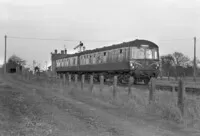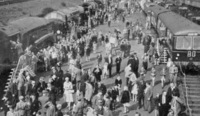Class 105/6 Cravens 2 & 3-car DMUs
Operations - Batch Three
ER power trailer sets - DMBSs 51254 - 301, DTCs 56412 - 59
This batch was split between Lincoln (40A - 51254-63/89-95/7/300/1) and Cambridge (31A 51264-88/96/8/9). Many of the routes for which the sets were built soon closed. Some sets had been intended for the former Midland & Great Northern (M&GN) line services, which would have involved some fairly long cross-country runs.
Lincoln
Lincoln vehicles (51284-8 + 56442-6) worked (along with 114s) Lincoln - Derby, Lincoln - Sheffield Victoria, Boston - Gainsborough then Doncaster or Sheffield Victoria, Grantham - Doncaster, and Cleethorpes - Peterborough or Doncaster.
The first part of the Grantham - Doncaster diesel diagram in the summer 1958 timetable (07:50 ex-Grantham, 10:20 ex-Doncaster, was worked by a 2-car set, although the next two turns were then taken over by a 3-car Derby set.
On August 2nd 1958 a 10-car formation worked the Saturday 06:50 Grimsby to Kings Cross and 15:52 return. It contained 51255/60-3 with 56413/18-21.
In 1978 51280/1/2/6/7/96 were still at Lincoln, operating with 56431/44/6/54/72.
Cambridge
The summer 1958 traffic on the Witham - Braintree and Witham - Maldon East lines were too much for the German railbuses. Steam was scheduled to be re-introduced, mentioned as a temporary measure till sufficient 105s were available which would work the two lines till the end of summer. In the event they did not revert to steam, as the Craven units arrived in time to take over for the period of heavy traffic.

The East Anglian units feature in film clips on the East Anglian Film Archive, including Saxmundham to Aldeburgh closure proposal (1960) and John Betjeman Goes By Train (1961).
The image shows E56444 on the rear (closest) arriving into Bottisham & Lode station on the Cambridge to Mildenhall line - date unknown. Steve Davies Collection.
In September 1964 the numerically highest five sets (51284-8 and 56442-6) were transferred to Norwich, around the time when another of their workings was lost with the closure of the Brightlingsea branch.
The vehicles which remained at Cambridge (51274-83/96 + 56432-41/54), along with the rest of its fleet, worked from Cambridge on local services and between Manningtree & Dovecourt and Witham & Maldon.
Later, certainly by 1967, the sets were joined by 51273/89-95 + 56412/47-53.

Great Northern Lines
In connection with the Borough of Wood Green Charter celebrations an exhibition of locomotives and rolling stock was held at Noel Park Goods Yard in Wood Green. The displays included 51261/56419 (with Spalding and Grimsby on the blinds). 14,000 people attended the event from Friday 12th to Sunday 14th September 1958.
In October 1958 the ER announced its intention to allocate 2-car Cravens sets to certain suburban services from and to Kings Cross on the Great Northern Line, with a planned start in the first half of the following year. The intended 20 units, later 28, taken from the M&GN fleet would not be suffice to cover the whole of the suburban service, the final scheme would be a combination of diesel hauled trains and DMUs.
Two sets were transferred to 34B (Hornsey) on paper in November 1958. On October 13th 1958 the two sets, 51261/56419 & 56415/51257 started on the Kings Cross suburban services. They were still based at Cambridge, where they attended each Saturday for periodical maintenance, running empty to Hertford. Initially they were used largely for crew training but they also provided some revenue earning off-peak services. On Mondays to Fridays their regular jobs were on the 12:40 Kings Cross - Hertford North, the 16:28 and 22:37 Finsbury Park to Hertford North, the 18:50 Kings Cross - Hatfield, the 12:01 and 17:31 Hertford North - Kings Cross and the 21:00 Hatfield to Kings Cross. They were being introduced on the line due to growing difficulties in maintaining the Class N2 0-6-2 tanks, as a stop gap till the full delivery of diesel locomotives and units. There was a fleet of twenty Craven twins planned, to be used on selective services, hopefully from the start of 1959.
By November 1958 the GN line Sunday services between Kings Cross & Hertford were completely diesel operated. The pattern of services was two DMU trains followed by one loco hauled (Class 26).
At the start of 1959 work on electrification on Sundays saw the line between Wood Green and Palmers Green closed, passengers being transported by bus. There was a service from Palmers Green to Hertford, operated on the 4th & 11th January by 51257/56415 & 51261/56419. The service from Wood Green to Kings Cross was operated by 51259/56417 & 51289/56447 on the 4th, but steam operated on the 11th.
An exhibition of locomotives and rolling stock was held in Lincoln in connection with the opening of the new Holmes Good shed on the 16th & 17th January 1959. All 45 exhibits were undercover in the new shed, and included a Cravens twin set.
By February 1959 the start date for the complete diesel service had slipped to the summer. On the 2nd February, sets started working to Kings Cross from Cambridge. The single diagram involved three trips, departing for London at 11:21, 15:26 and 23:25.
On the Hertford North branch on the first day of normal daily working south of Crews Hill (March 23rd) the 08:11 Gordon Hill - Moorgate did not run. On the 24th a 6-car set (three twins) commenced daily operation on this train. This was an interesting development as it had been officially stated that diesel units were not permitted over the widened lines to Moorgate.
The promised sets (originally quoted as to be 51254-72 + 56412-30) were eventually transferred to Hornsey, mainly in 6/59. They later shifted to Finsbury Park. Official re-allocation dates were Feb 1959: 51263/56421, May 1959: 51291-5/56449-53, Jun 1959: 51255/6/64-73 with 56413/4/22-31/54, and in Jul 1959 51297-301 & trailers and 51471/2 & 56460/1. Vehicles (51297-301 + 56455-9 along with the two batch four ER vehicles 51471/2 + 56460/1) apparently oscillated between Finsbury Park and Lincoln several times (with and without their proper trailers).
The summer 1959 timetable saw the former irregular Great Northern Suburban service replaced by a basic 30-min interval service in the off-peak hours. On the main line there was an all stations to Hatfield train from Finsbury Park at 11 mins past each hour, taking 39 mins compared with the previous 44. At 40 mins past each hour a faster service left Kings Cross, calling at Finsbury Park, Oakleigh Park, and all stations to Welwyn Garden City, reached in 46 mins. On the Hertford line, departures were at 3 and 30 mins past the hour from Kings Cross, the former connecting at Finsbury Park with the slow Hatfield train and then omitting Harringay and Hornsey to reach Hertford in 48 mins, and the latter stopping at all stations and taking 51 mins as compared to 57 previously.
In the reverse direction similar arrangements applied except the all stations from Hertford at 58mins past the hour, which terminated at Finsbury Park, the stock forming the all stations return to Hatfield at 11mins the hour, 73 mins later. These were all 105 operated. In the peak hours, services were loco hauled.
On Sundays, the whole inner suburban service was operated by 105s, with the Baldock & Cambridge services in the hands of steam / diesel locos, apart from three down and two up runs.
The revised G.N. suburban services from the 15th May had a "we mean business" feel to them. Loud-hailers were used for announcements at most stations without public address systems, and station masters were very much in evidence. It was quoted at this time that the 105s were only a temporary measure, to be replaced by Derby/Rolls Royce 3-car sets.
While there was a lot of problems with the diesel locos on the peak hour services, the 105s seemed to behave themselves. The first class was converted to a 'non-smoking' compartment, although the first class seats remained. Some juggling with the sets occurred and resulted in the appearance of a 3-car set (51298/51293/56456) which operated for about a week. A power twin of 51266/51269 was also noted, their trailers being left at Finsbury Park.
The vehicles, although reliable, had a bad reputation with the public, due to the tremendous rattling noises they made, produced by the vibrating sliding window toplights, door droplights and metal luggage racks.
They were pushed to the limit to keep services running. Being two-car units they proved to be unsuitable for these services, as they were underpowered for frequent stopping & starting, and tended to overheat. The summer of 1959 was very hot, and watering cans had to be provided at each station en-route for topping up. The overheating also caused low oil pressure, and to keep the sets in service the safety cut-out relays had to be cut. They were disliked by the passengers who had been used to high density articulated vehicles, as these only had two side doors per vehicle, bus type seats, and many unusable areas (cabs/vans) in a 6/8-car set.

The image shows sets in Kings Cross York Road platform, circa 1970. Tony Wilkins.
These youtube videos - part one and part two feature lots of Cravens sets in the London area in 1976.
When Kings Cross was electrified in 1977 the Cravens sets were replaced from the 3rd October by Class 312 EMUs. The sets were then scattered to locations such as Ayr and Tyseley.
Misc
Sets were known to work Cambridge - Birmingham services. In the early seventies a small number of the early ER power trailers went to the north west to replace Carlisle's Derby Lightweights.
Summary
Orders
Description - General
Description - Variations
Description - Interior
Works Photos & Drivers Inst.
Diagrams
Numbering
Liveries
Operations - Batch One
Operations - Batch Two
Operations - Batch Three
Operations - Batch Four
Operations - Scotland
Accidents
Decline
Parcel Use
Other Non-Passenger Use
Images
Details about preserved Class 105s can be found here.


